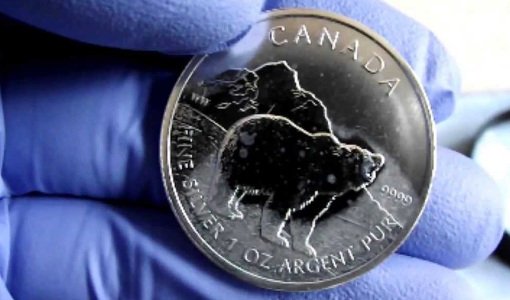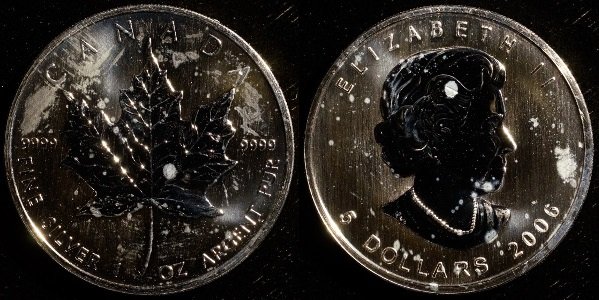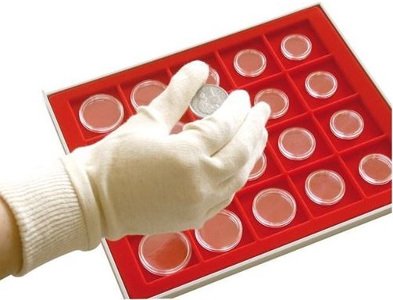Curse of the Silver Stacker : Milk Spots
So you bought some nice Silver coins and pull them out months or years later to marvel at their beautiful designs….and there they are. Milk Spots! Your coins have these cloudy, splotchy blemishes that ruin the aesthetic appeal of your cherished coin and now nobody will buy them from you for anything more than the Spot metal price and they look ugly too. If there is one thing that can ruin the premium on a semi-numismatic or numismatic Silver coin, this is it – The Curse of the Silver Stacker.

Source
There are a few newer stackers in the #steemsilvergold group that might not be aware of this issue that can plague a number of popular coin series. While it is a sad and sometimes distressing subject, it is worth talking about so that some precautions can be taken.

Source
There is a bit of mystery about what causes Milk Spots and there is no guaranteed cure. Even though some people claim they can repair or clean Milk Spotted coins, the success rate is usually low and there is often also some residual scratches or abrasions that still render the coin to be pretty much junk status in the eyes of a collector.

Source
The prevailing theory is that Milk Spots originate from some kind of contaminant or debris during the minting process. Perhaps some dust, dirt or even detergent that gets into the coin surface during or after striking. It’s a controversial topic for Mints and their response to producing coin series which subsequently develop Milk Spots is varied. Some endeavour to implement higher cleanliness standards during the minting process, while others deny responsibility. Others again seem to not care.

Source
So what do the budding stackers amongst us do about Milk Spotting? Firstly, it is important to be aware if the coin series you are looking to buy has any known Milk Spotting issues. Secondly, check to see if the Mint producing the coin series has a track record of having Milk Spot complaints. Thirdly, make sure you handle and store your coins well. You should never touch your silver with your bare hands if you want to preserve your coins premium value. Always use gloves as the natural oils in your hand can cause tarnish and make these types of problems worse. Also, it is a good idea to keep your coins in an air tight plastic capsule so that it is not subjected to humidity or other contamination that could lead to Milk Spotting.

Source


https://www.youtube.com
https://www.piccutalaw.com
http://numismax.com
https://memegenerator.net
http://www.eldoradocoins.de
Well, you can still purify water with them.
In my experiance with 1 oz Maples over a 10 year period, I have found that the milk spots appeared after the transition to tubes only. Thousands of Ag maples in sheets w/o a single milk spot. 88/89 Ag Maples were issued in a thicker plastic which usually yeilded some toning w/o milk spots.
From my experience with Ag maples concerning the numismatics side I found that the 1997 key date coins (low mintage) and NGC/PCGS Ms70 rated are the popular choice. Even the proof issue from 99' is nice.
Coin Population is important when veiwing the different variables on Numismatic Value.
Interesting. Thanks for sharing your experience.
Maybe I can make a top ten of mints with this problem : Nr 1-9: Royal Canadian Mint and on Nr 10 UK Royal Mint. Some other mints show spots like panda, wedgetailed series, ruanda but it never covers entire parts of the coin as with the RCM bullion coins. Maybe it is the rainy climate!
I don't think anyone could blame the rain. RCM are clearly the worst offender and they don't seem to care. I won't pay for any premium or collectable coins from RCM any more. Learnt that the hard way.
Milk spots on my new coins will make me sad but I’d be happy to buy any spotty coins for spot.
I didn't even know that was a thing. You can probably deduce from that statement that I'm still new to the game. ;)
Good to know for when I start collecting high-value coins though!
I've just checked my coins immediately after reading this post (didn't take long because I have only a few).
Maple Leaf 2013 - I was aware one of the coins had a milk spot that appeared a few weeks after I had gotten them (same year as series). But it had not deteriorated since then. The others, including Australian Kangaroo 2016, US Walking Liberty 2016 etc. are free from milk spots too, thankfully.
I'm surprised by the extent of your coins here. Might weather be a factor? I'm in Malaysia where it's hot and humid most of the time.
They aren't my coins. I was being lazy and just showing the worst examples I could find.
NO NOT A MILK SPOT!!!!!
Dip it! Antique it! or... Melt it!
I had the same problem my friend. I learned how to antic coins and i fell a little bit better about the cosmetics. Still a beautiful coin. No worries my friend still 1 oz of 4 9's silver.
Other than the Royal Canadian Mint, is there any other mints that have this problem? Do you know if the Royal Australian Mint or the Royal Mint have this problem?